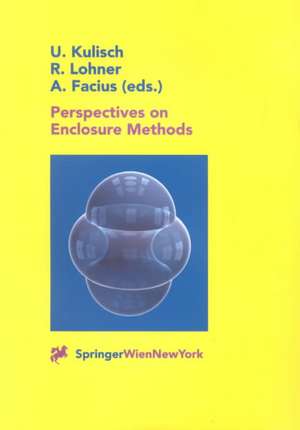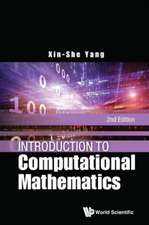Perspectives on Enclosure Methods
Editat de Ulrich Kulisch, Rudolf Lohner, Axel Faciusen Limba Engleză Paperback – 18 iun 2001
Preț: 395.47 lei
Nou
Puncte Express: 593
Preț estimativ în valută:
75.68€ • 80.92$ • 63.09£
75.68€ • 80.92$ • 63.09£
Carte tipărită la comandă
Livrare economică 18 aprilie-02 mai
Preluare comenzi: 021 569.72.76
Specificații
ISBN-13: 9783211835906
ISBN-10: 3211835903
Pagini: 368
Ilustrații: XII, 345 p.
Dimensiuni: 170 x 244 x 19 mm
Greutate: 0.59 kg
Ediția:Softcover reprint of the original 1st ed. 2001
Editura: SPRINGER VIENNA
Colecția Springer
Locul publicării:Vienna, Austria
ISBN-10: 3211835903
Pagini: 368
Ilustrații: XII, 345 p.
Dimensiuni: 170 x 244 x 19 mm
Greutate: 0.59 kg
Ediția:Softcover reprint of the original 1st ed. 2001
Editura: SPRINGER VIENNA
Colecția Springer
Locul publicării:Vienna, Austria
Public țintă
ResearchCuprins
Proving Conjectures by Use of Interval Arithmetic.- 1 Computer Assisted Proofs in Analysis.- 2 The Kepler Conjecture.- 3 The Double Bubble Conjecture.- 4 The Dirac-Schwinger Conjecture.- 5 ‘Chaos conjectures’.- References.- Advanced Arithmetic for the Digital Computer Interval Arithmetic Revisited.- 1 Introduction and Historical Remarks.- 2 Interval Arithmetic, a Powerful Calculus to Deal with Inequalities.- 3 Interval Arithmetic as Executable Set Operations.- 4 Enclosing the Range of Function Values.- 5 The Interval Newton Method.- 6 Extended Interval Arithmetic.- 7 The Extended Interval Newton Method.- 8 Differentiation Arithmetic, Enclosures of Derivatives.- 9 Interval Arithmetic on the Computer.- 10 Hardware Support for Interval Arithmetic.- References.- Highly Accurate Verified Error Bounds for Krylov Type Linear System Solvers.- 1 Introduction.- 2 Iterative Solvers and Finite Precision.- 3 Krylov Subspace Methods.- 4 Improved Arithmetic.- 5 Verified Error Bounds.- 6 Computational Results.- References.- Elements of Scientific Computing.- 1 Hardware Requirements.- 2 Software Requirements.- 3 Modelling Requirements.- 4 Conclusion.- References.- Biography.- The Mainstreaming of Interval Arithmetic.- 1 Introduction.- 2 Moore’s Law and Precision.- 3 Interval Physics.- 4 Summary.- References.- Bounds for Eigenvalues with the Use of Finite Elements.- 1 Introduction.- 2 Setting for the Problem.- 3 Calculation of Bounds.- 4 Verified Computation.- 5 Application: the Membrane Problem.- 6 Numerical Examples.- References.- Algorithmic Differencing.- 1 Algorithmic Representation of Functions.- 2 Transformation of Algorithms.- 3 Finite Precision Calculations.- 4 First Order Difference Operators.- 5 Differences of Inverse Functions.- 6 Higher Order Divided Differences.-References.- A Comparison of Techniques for Evaluating Centered Forms.- 1 Introduction.- 2 Methods for Computing Slope Vectors.- 3 A Numerical Example.- 4 Summary and Recommendations.- References.- On the Limit of the Total Step Method in Interval Analysis.- 1 Introduction.- 2 Notations.- 3 Results.- References.- How Fast can Moore’ Interval Integration Method Really be?.- 1 Introduction.- 2 Moore’s Algorithm.- 3 Estimation of the Integration Error.- 4 Conclusions.- References.- Numerical Verification and Validation of Kinematics and Dynamical Models for Flexible Robots in Complex Environments.- 1 Introduction.- 2 Error Propagation Control and Reliable Numerical Algorithms in MOBILE.- 3 Verified Calculation of the Solution of Discrete-Time Algebraic Riccati Equation.- 4 Accurate Distance Calculation Algorithms.- 5 Accurate Robot Reliability Estimation.- 6 Further Work.- 7 Acknowledgement.- References.- On the Ubiquity of the Wrapping Effect in the Computation of Error Bounds.- 1 Introduction or What is the Wrapping Effect?.- 2 Where does the Wrapping Effect appear?.- 3 How can we Reduce the Wrapping Effect?.- 4 Conclusion.- References.- A New Perspective on the Wrapping Effect in Interval Methods for Initial Value Problems for Ordinary Differential Equations.- 1 Introduction.- 2 Preliminaries.- 3 How the Wrapping Effect Arises in Interval Methods for IVPs for ODEs: A Traditional Explanation.- 4 The Wrapping Effect as a Source of Instability in Interval Methods for IVPs for ODEs.- 5 The Parallelepiped and Lohner’s QR-Factorization Methods.- 6 Why the Parallelepiped Method Often Fails.- 7 When Does the Parallelepiped Method Work Well.- 8 How the QR Method Improves Stability.- 9 Conclusions.- A Lemmas.- References.- A Guaranteed Bound of the Optimal Constant in theError Estimates for Linear Triangular Elements.- 1 Introduction.- 2 Strategy.- 3 The Method to Calculate a Rigorous Solution.- 4 Checking the Condition.- 5 Some Computational Techniques for Efficient Enclosure Methods.- 6 Numerical Results.- References.- Nonsmooth Global Optimization.- 1 Introduction.- 2 Preliminaries.- 3 A Pruning Technique for Global Optimizationx.- 4 Multidimensional Pruning Techniques for Global Optimization.- References.
Caracteristici
Introduction to a most advanced research field in scientific computing Interesting applications Latest research results













